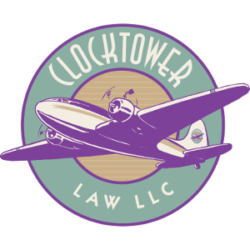A trademark is to your business as a foundation is to your house.

This is part one in an ongoing series about why and how to register your trademarks. Erik J. Heels is both the founder of domain name, trademark, and patent law firm Clock Tower Law Group and the owner of many trademarks and domain names.
The Problem: Unregistered Trademarks
In the summer of 2003, Clock Tower Law Group surveyed 100 companies and discovered that each company had, on average, four unregistered trademarks.
The Solution: Register Trademarks With The USPTO
Trademark rights are established primarily by using a particular trademark and can last as long as the trademark is in use. So why register the trademark with the United States Patent and Trademark Office (USPTO)?
Benefits Of Federal Trademark Registration
- Register your trademark to protect your brand. A brand (such as “Apple”) can support multiple trademarks and multiple domain names. Each trademark covers specific goods and services.
- Register your trademark to protect your domain names. Registered trademark owners win 80% of their battles with cybersquatters in UDRP domain name disputes.
- Register your trademark to protect your company name.
- Register your trademark to protect your logo.
- Register your trademark to protect your product names.
- Register your trademark to protect your service names.
- Register your trademark to protect your slogans.
- Register your trademark to protect your taglines.
Registration in the Principal Register provides:
- Notice to others that the mark is taken.
- Right to put the “circled-R” symbol (®) after the mark.
- Right to recover triple damages and attorneys’ fees from an infringer.
- Exclusive ownership of the mark (excepting prior use) in the United States.
How To Choose Good Trademarks
There is one simple rule for choosing a good trademark: the weirder the better.
The following categories of marks are listed from strongest to weakest.
- “Fanciful” marks are the strongest trademarks. Fanciful marks consist of one or more made-up words. Examples include EXXON, KODAK, VERIO, and XEROX.
- “Arbitrary” marks are very strong trademarks. Arbitrary marks consist of real words that have nothing inherently to do with the product/service being sold. Computers have nothing inherently to do with apples, so APPLE is a good trademark for a computer company. Examples include APPLE (computers), AMAZON (books), and SUN (computers).
- “Suggestive” marks are strong trademarks. Suggestive marks consist of real words that suggest a quality that the company or its products/services stand for. Greyhounds suggest speed, so GREYHOUND is a good name for a bus company.
- “Descriptive” marks are weak trademarks. Examples include “Computer Equipment Store” and “Word Processor.”
- “Generic” marks are those that refer to a category of goods/services instead of a particular company’s products/services. Some marks used to be distinctive but have become generic. Examples of “genericized” former trademarks include ASPIRIN, LINOLEUM, ESCALATOR, and NYLON.
Trademarks need to be distinctive in order to qualify for registration in the Principal Register. Some marks may be able to acquire distinctiveness and can be placed in the Supplemental Register.
But you’re better off choosing a distinctive mark from the get-go than fighting the “acquired distinctiveness” battle.
The Case Study: RedStreet
When Rick Klau and I formed RedStreet in 1997, we thought long and hard about the name. RedStreet provided Internet services to the legal profession.
I recall many brainstorming sessions where we tried to come up with a name that was unique, memorable, easy to spell, and (most importantly) one for which a domain name was available.
I recall that “sleet.com” was available as was “octopus.com” but those don’t necessarily conjure up good images. We used random word/name generators to come up with some names (“vovasi.com” comes to mind), but none of those were very good. (In hindsight, we could have registered those and many other domain names and retired by now, but that’s another story.)
I recall one company called “Mt. Xinu” which took its name from “UNIX(tm)” spelled backwards. That led to RedMountain (taken) and finally RedStreet.
As it turns out, you can also spell “RedStreet” entirely with your left hand on the keyboard. So that’s a plus.
The name “RedStreet” is much better than “legal this,” “law that,” or “web the other thing.” It was an empty vessel that we filled with meaning.
The Trademark: RedStreet
For several years, Rick and I ran RedStreet as a part-time venture while we each tried to figure out where Web 1.0 would take us. It ended up taking me to Clock Tower Law Group via Verio, Rick to Google via FeedBurner.
Eventually, RedStreet (the company) was dissolved. But the IP assets (the website, the domain name, the trademark) lived on. Rick and I split up the domain names and the other IP assets and went our separate ways. I got redstreet.com and some others, Rick got onsemble.com and some others.
On 01/01/07, GiantPeople LLC (my consulting company, the new owner of the RedStreet IP assets, and also the owner of this blog) relaunched the RedStreet website, which is now primarily an archive (like Archive.org) of law firm website reviews from the late 1990s.
Which brings us full circle. Because GiantPeople, like most companies, has unregistered trademarks, most notably the RedStreet trademark.
So, on 11/26/08, Clock Tower Law Group filed a use-based trademark application for RedStreet. I will not be able to live-blog or live-tweet the trademark application, but I will use the RedStreet trademark application as an ongoing case study for how the trademark registration system works.
If all goes well, the entire process from filing to registration should take about a year. So stick around, there will be more.



[EDITOR’S NOTE: In the summer of 2025, Clocktower Intern Mark Magyar used artificial intelligence (AI) software to shorten over 100 Clocktower articles by 17%. The shortened articles are included as comments to the original ones. And 17 is the most random number (https://www.giantpeople.com/4497.html) (https://www.clocktowerlaw.com/5919.html).]
* How To Register A Trademark: Part 1: Choosing A Good Name
A trademark is to your business as a foundation is to your house.
This is part one in a series on why and how to register your trademarks. I’m Erik J. Heels, founder of trademark/patent firm Clock Tower Law Group and owner of many trademarks and domains.
The Problem: Unregistered Trademarks
In 2003, Clock Tower surveyed 100 companies and found each had, on average, four unregistered trademarks.
The Solution: Register with the USPTO
Trademark rights arise through use and last as long as the mark is used. So why register with the USPTO?
Benefits of Federal Registration:
Protects your brand, which can include multiple marks and domains.
Strengthens domain name defenses; registrants win 80% of UDRP disputes.
Protects company names, logos, products, services, slogans, and taglines.
Principal Register benefits: notice to others, ® symbol, triple damages, attorneys’ fees, and exclusive nationwide rights (subject to prior use).
How to Choose Good Trademarks
Rule of thumb: the weirder, the better.
From strongest to weakest:
Fanciful: made-up words (EXXON, KODAK, XEROX).
Arbitrary: real words unrelated to the product (APPLE for computers, AMAZON for books).
Suggestive: words hinting at qualities (GREYHOUND for buses).
Descriptive: weak (e.g., “Word Processor”).
Generic: weakest (e.g., “Aspirin,” “Escalator,” now genericized).
Distinctiveness is key. Better to start strong than fight for “acquired distinctiveness.”
Case Study: RedStreet
When Rick Klau and I founded RedStreet in 1997 (Internet services for law firms), we brainstormed endlessly. Available names included sleet.com and octopus.com (not great images). We tried random generators (e.g., vovasi.com) with little success. One firm used “Mt. Xinu” (UNIX backward), which inspired “RedMountain” (taken) and finally RedStreet — memorable, unique, and easy to spell. Bonus: it can be typed with just your left hand.
Better than “law-this” or “legal-that,” RedStreet was an empty vessel we filled with meaning.
The Trademark: RedStreet
Rick and I ran RedStreet part-time until it dissolved, splitting IP assets. I kept redstreet.com; Rick kept onsemble.com.
On 01/01/07, GiantPeople LLC (my consulting firm) relaunched RedStreet as an archive of late-1990s law firm website reviews.
But like most companies, GiantPeople had unregistered marks — including RedStreet. So, on 11/26/08, Clock Tower filed a use-based application for RedStreet.
I’ll use this application as a case study for how the USPTO process works. If all goes smoothly, registration should take about a year. Stick around.
* How To Register A Trademark: Part 1: Choosing A Good Name (2009-02-11)
A trademark is to your business as a foundation is to your house.
https://www.clocktowerlaw.com/3071.html
* How To Register A Trademark: Part 2: Trademark Search (2009-03-11)
Search trademarks to rule out likelihood of confusion.
https://www.clocktowerlaw.com/3073.html
* How To Register A Trademark: Part 3: Trademark Filing (2009-04-07)
File your trademark application with TEAS.
https://www.clocktowerlaw.com/3075.html